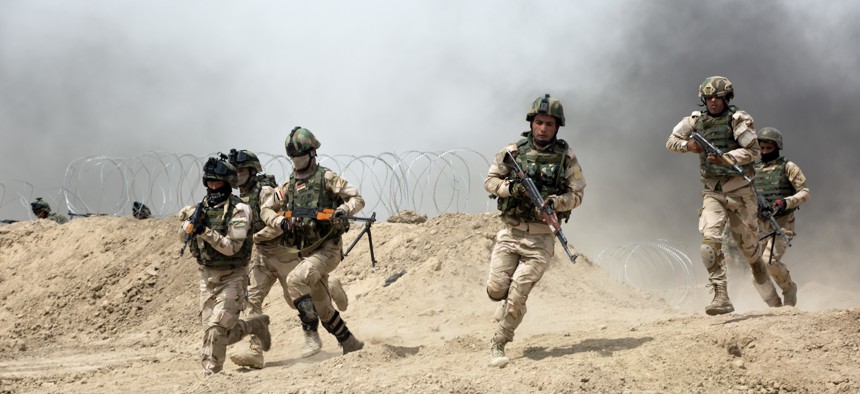
Iraqi soldiers run through a breach in a berm while training at Camp Taji, Iraq, on June 2, 2015. U.S. Army photo by Sgt. Charles M. Bailey, CJTF-OIR Public Affairs
Video Chat Could Put US Advisors In ISIS Fight — Virtually
US troops confined to Iraqi bases may soon use FaceTime-like apps to help Iraqi soldiers on the battlefield.
Picture messaging and video chat technology similar to Skype or Apple’s FaceTime could soon enable U.S. troops to accompany Iraqis on patrol — at least virtually.
The U.S. military is already testing the idea in Afghanistan, said Steve Weiler, who directs requirements for the Joint IED Defeat Organization, or JIEDDO. “We’re looking at commercial-off-the-shelf, inexpensive technology,” including cellphones and tablets running Android apps developed by JIEDDO, Weiler said Thursday.
The setup is similar to videoconferencing equipment used by medics in austere locations to communicate remotely with doctors, he said. “As soon as we get the feedback on how well that went, we’ll tweak the program [and] make some technical modifications.”
Weiler and other JIEDDO officials think such gear could allow the several thousand U.S. troops who train and advise Iraq’s security forces — but who are forbidden to leave their bases — to provide real-time guidance when, say, an Iraqi soldier finds a roadside bomb planted by ISIS.
“What if the force that’s forward comes across a particularly different kind of IED that they’ve got to disarm?” said JIEDDO’s director, Army Lt. Gen. John Johnson. New gear could allow them to “reach back to experts who can see what they’re seeing and help guide them on their solution.”
“These are the kinds of ideas that are being batted around,” Johnson said, “as we look at ‘how do we better enable our partners without creating a logistics problem for them, without creating a significant training problem for them.’”
IEDs, so deadly to American forces in Iraq and Afghanistan, have returned as a potent weapon for the Islamic State. Over the past month, ISIS has detonated more than 500 IEDs in Iraq and Syria, killing nearly 1,000 people and injuring about 700, according to JIEDDO.
Johnson’s organization, which looks for ways to detect and dismantle IEDs and to predict what new variants might soon appear, was among the first to send advisors to Iraq last year. Today, about 50 members of the group are there. Last week, Defense Secretary Ashton Carter told the House Armed Services Committee that the Pentagon was expediting counter-IED equipment to Iraq.
But IED technology evolves at lightning speed. Before the U.S. withdrew its combat troops, Johnson said, the military was “awash in data” from blast sites, information that guided the development and deployment of counter-IED gear. But these days, U.S. troops stay on military bases. (Embedding them within Iraqi units on the battlefield would require more U.S. support units closer to the fight.)
Since there are no IED experts embedded with Iraqi forces on the battlefield, JIEDDO lacks information about the newest bombs being used by ISIS. The Iraqi and Afghan forces “are not equipped in the same way we are,” Johnson said. “They don’t have the same capability to observe and report...They don’t have the same capability to recover and analyze.”
That’s where the smartphones, tablets and other types of communication gear could help. “We’re looking to overcome that now with other means because we need that information to be able to understand what’s going on and help them with that because … the enemy adapts on a dime,” Johnson said.
Today, U.S. troops are in the early stages of teaching the Iraqis how to use tablets to capture what they are seeing on the battlefield. Language barriers and other challenges abound, but the goal is to enable FaceTime-like video chat.
After that? JIEDDO officials say virtual advising could find use well beyond Iraq and Afghanistan.


